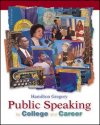Much of the success of a speech depends on how well the speaker handles the
introduction and conclusion. The introduction consists of two parts: attention
material, which gains listeners' attention and interest, and orienting material,
which gives the audience the information they need to listen intelligently to
the rest of the speech. For attention material, you can use one or more of the
following techniques: tell a story, ask a question, make a provocative statement,
cite a quotation, arouse curiosity, provide a visual aid or demonstration, and
provide the audience with an incentive to listen. For orienting material, you can preview the body of
the speech by stating the central idea, the main points, or both. You also can
give any necessary background information, such as definitions, and you can
establish your credibility by stating why you and your sources are trustworthy. The introduction should have a direct and obvious tie-in
with the body of the speech. Avoid apologies and a too-brief introduction. The conclusion of your speech should signal the end, summarize
your key ideas, and reinforce the central idea with a clincher. A clincher may
be an appeal or challenge, an illustration, a reference to the introduction,
or any of the techniques mentioned for attention material (such as a rhetorical
question). Avoid conclusions that are weak, apologetic, or drawn-out.
While fresh material may be used, never bring in new main points. |



 2002 McGraw-Hill Higher Education
2002 McGraw-Hill Higher Education